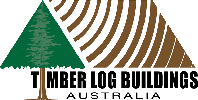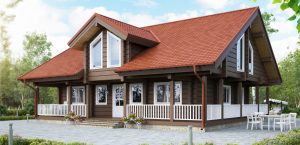
Facts about Fire
Solid Timber is resistant to fire
The use of timber for residential dwellings has been around for hundreds of years. Timber is still nowadays one of the most commonly used building materials for framing, structural components, cladding and flooring. Whilst being combustible by its very nature, it is considered to be one of the safest and environmentally friendliest building materials used today.

Deliberate Charring of Timber
to Create a Protective Layer
Solid Timber is resistant to fire. It burns at a slow rate, and doesn’t melt or suddenly collapse as steel can when heated. Fire needs air to burn and because solid timber has no middle air cavity like conventional buildings, timber has to burn from the outside in.
Fire Resistance
When solid timber is exposed to high temperatures it will burn and begin to decompose to provide an insulating surface layer of char that retards further degradation of the wood. The rate of char on the outside of the timber log is initially fast but as the depth of char increases, the rate of char slows because of the increasing insulation provided.
Strength
Although Timber is a combustible material, when it burns, this surface layer of char is created which helps to protect and maintain the strength and structural integrity of the remaining un-burnt Timber beneath. Engineered pine solid wood walls have a char rate of 0.6mm per minute.
Fact
Most building fires are started by heat sources that ignite materials such as furnishings, curtains, synthetic carpets and so on. These can be highly flammable and it is these materials that emit dangerous toxic fumes. A building structure such as a timber log cabin is usually not the first material ignited.
Science
Solid timber is a great insulator and a poor conductor of heat and electricity. Wood is a much better insulator than steel, concrete and glass.
Reference Materials
Fire Performance of Timber Log Walls (pdf file)
Performance of solid timber walls under simulated bushfire conditions (pdf file)
In 2010 the "Finnish Log House Association" issued an excellent document called "DESIGN PRINCIPLES FOR LOG BUILDINGS", providing a comprehensive overview of all relevant topics - the topic of "Fire Resistance of Log Structures" is covered on page 8:
 1. TERMINOLOGY
1. TERMINOLOGY
2. MOISTURE CHARACTERISTICS OF WOOD
3. SPECIAL CHARACTERISTICS OF LOG BUILDINGS
3.1 Settling
3.2 Breathability and tightness
3.3 Durability and protection of a log wall
3.4 Lengthening of logs
4. DESIGN PRINCIPLES FOR LOG STRUCTURES
4.1 Load-bearing capacity
4.2 Energy efficiency and heat losses
4.2.1 Provisions 2008–2010
4.2.2 Provisions 2010
4.2.3 Thermal insulation characteristics of log walls
4.3 Moisture behavior of log walls
4.4 Moisture proofing
4.5 Fire resistance of log structures
4.6 Sound-insulation capacity of a log wall
4.6.1 Uninsulated log walls
4.6.2 Log walls with additional insulation on the inside or outside
4.7 Ventilation of buildings
5. STORAGE AT THE WORK SITE
6. CONDITIONS FOR THE LOG FRAME ERECTION
And an interesting article we came across in "The Sydney Morning Herald" 11 March 2009:
https://www.smh.com.au/national/log-home-stands-as-new-building-regulations-come-into-effect-today-20090310-8u6a.html









